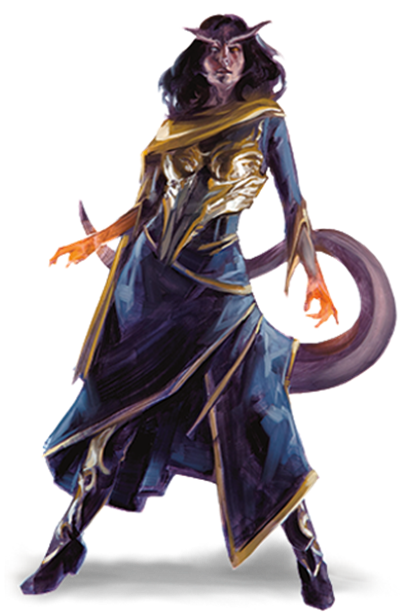Overview
To be greeted with stares and whispers, to suffer violence and insult on the street, to see mistrust and fear in every eye: this is the consequence of being a tiefling. And to twist the knife, tieflings know that this is because a pact struck generations ago infused the essence of
Asmodeus - overlord of the Nine Hells - into their bloodline. Their appearance and their nature are not their fault but the result of an ancient sin, for which they and their children and their children’s children will always be held accountable.
Humans with the blood of fiends, most tieflings in Faerûn share a common connection due to the machinations of the archdevil Asmodeus a century ago.
Infernal Bloodline
Tieflings are derived from
human bloodlines, and in the broadest possible sense, they still look human. However, their infernal heritage has left a clear imprint on their appearance. Tieflings have large horns that take any of a variety of shapes: some have curling horns like a
ram, while others have straight and tall horns like a
stag’s. They have thick tails, four to five feet long, which lash or coil around their legs when they get upset or nervous. Their canine teeth are sharply pointed, and their eyes are solid colors - black, red, white, silver, or gold - with no visible pupil. Their skin tones cover the full range of human coloration, but also include various shades of red. Their hair, cascading down from behind their horns, is usually dark, from black or brown to dark red, blue, or purple.
Self-Reliant and Suspicious
Tieflings subsist in small minorities found mostly in
human cities or towns, often in the roughest quarters of those places, where they grow up to be swindlers, thieves, or crime lords. Sometimes they live among other minority populations in enclaves where they are treated with more respect.
Lacking a homeland, tieflings know that they have to make their own way in the world and that they have to be strong to survive. They are not quick to trust anyone who claims to be a friend, but when a tiefling’s companions demonstrate that they trust him or her, the tiefling learns to extend the same trust to them. And once a tiefling gives someone loyalty, the tiefling is a firm friend or ally for life.
Mutual Mistrust
People tend to be suspicious of tieflings, assuming that their infernal heritage has left its mark on their personality and morality, not just their appearance. Shopkeepers keep a close eye on their goods when tieflings enter their stores, the town watch might follow a tiefling around for a while, and troublemakers blame tieflings for strange happenings. The reality, though, is that a tiefling’s bloodline doesn’t affect his or her personality to any great degree. Years of dealing with mistrust does leave its mark on most tieflings, and they respond to it in different ways. Some choose to live up to the wicked stereotype, but others are virtuous. Most are simply very aware of how people respond to them. After dealing with this mistrust throughout youth, a tiefling often develops the ability to overcome prejudice through charm or intimidation.
The Mark of Asmodeous
During the Spellplague,
Asmodeus consumed the divine spark of
Azuth and thereby achieved godhood. Subsequently, Asmodeus and a coven of warlocks, the Toril Thirteen, performed a rite wherein the archdevil claimed all tieflings in the world as his own, cursing them to bear “the blood of Asmodeus.” This act marked all tieflings as “descendants” of the Lord of the Nine Hells, regardless of their true heritage, and changed them into creatures that resembled their supposed progenitor. The other folk of Faerûn, unnerved by the appearance of these
devil-beings, became suspicious of all tieflings and occasionally hostile to them.
In spite of what some people believe, however, Asmodeus exerts no power over his “children,” and tieflings today are as free-willed - and willful - as they ever have been. Some do choose to serve the Lord of the Nine Hells and his schemes, while others align themselves with different fiendish factions, or none at all, doing their best to stay out of infernal politics.
A Race Without a Home
As offspring of the infernal, tieflings call no place in Faerûn their own, although some places and nations are more tolerant of them than most.
The largest population of tieflings is found in
Neverwinter. Since the Ashmadai, a violent cult dedicated to
Asmodeus, is also active in the city, mistrust of tieflings isn’t unusual even here, since folk never know if a tiefling is a member of the Ashmadai or was drawn to Neverwinter by the opportunity to blend in that a metropolis provides.
Small and scattered groups of tieflings are found elsewhere across Faerûn, particularly in cosmopolitan cities (where they can be anonymous to some degree) and in rough and poor settlements that welcome anyone who can help them survive and prosper.
Lone Faithful
Although many Faerûnian folk believe that all tieflings worship
Asmodeus and the Lords of the Nine Hells, the truth is that only a fraction of them do so, but enough do worship
devils or
demons to lend the weight of truth to all the rumors and suspicion.
Tieflings who revere a god other than Asmodeus often worship deities who watch over and care for outsiders, including
Ilmater,
Mask,
Selûne,
Shar, and
Tymora. Gods of knowledge, survival, cunning, and warfare are also common attractions for tieflings who value those qualities.
Beshaba has tiefling worshipers who consider the accident of their birth as a kind of cruel joke they have chosen to embrace.
Equally intriguing and disturbing to followers of some faiths in Faerûn are stories spread by tieflings who claim to have visions in which the gods of Faerûn appear to them modeled in the tieflings’ own image. One such is the entity they call the “pale horned goddess of the moon” (Selûne another is the “dark, devilish lady of fortune” (Tymora) - an indication, tieflings say, that one’s outward appearance and bloodline are less important to the gods than the heart and soul within.
Tiefling Names
A great many tiefling parents follow the naming conventions of the culture in which their offspring are born, such as using
human names if they live in a human settlement (the better to seem like “normal” citizens). Others take names derived from the Infernal language that have been passed down since ancient times.
Tiefling Traits
Tieflings share certain racial traits as a result of their infernal descent.
Ability Score Increase
Your Intelligence score increases by 1, and your Charisma score increases by 2.
Age
Tieflings mature at the same rate as
humans but live a few years longer.
Alignment
Tieflings might not have an innate tendency toward evil, but many of them end up there. Evil or not, an independent nature inclines many tieflings toward a chaotic alignment.
Size
Tieflings are about the same size and build as
humans. Your size is Medium.
Speed
Your base walking speed is 30 feet.
Darkvision
Thanks to your infernal heritage, you have superior vision in dark and dim conditions. You can see in dim light within 60 feet of you as if it were bright light, and in darkness as if it were dim light. You can’t discern color in darkness, only shades of gray.
Hellish Resistance
You have resistance to fire damage.
Infernal Legacy
You know the
thaumaturgy cantrip. When you reach 3rd level, you can cast the
hellish rebuke spell as a 2nd-level spell once with this trait and regain the ability to do so when you finish a long rest. When you reach 5th level, you can cast the
darkness spell once with this trait and regain the ability to do so when you finish a long rest. Charisma is your spellcasting ability for these spells.
Languages
You can speak, read, and write Common and Infernal.



Comments